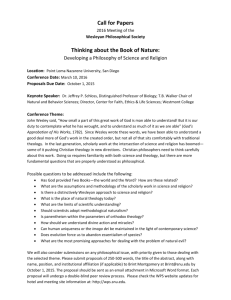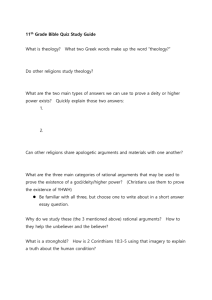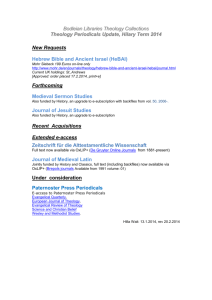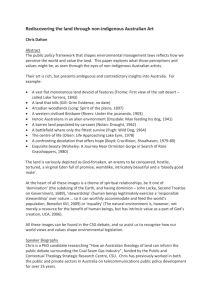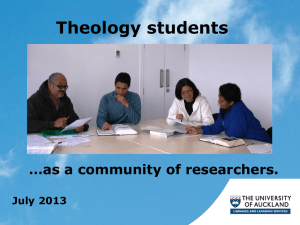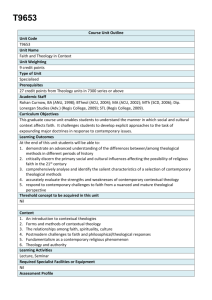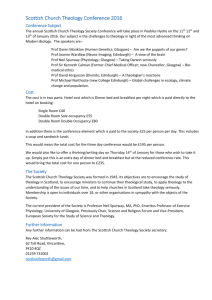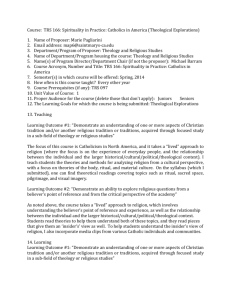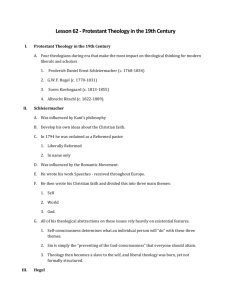View/Open
advertisement
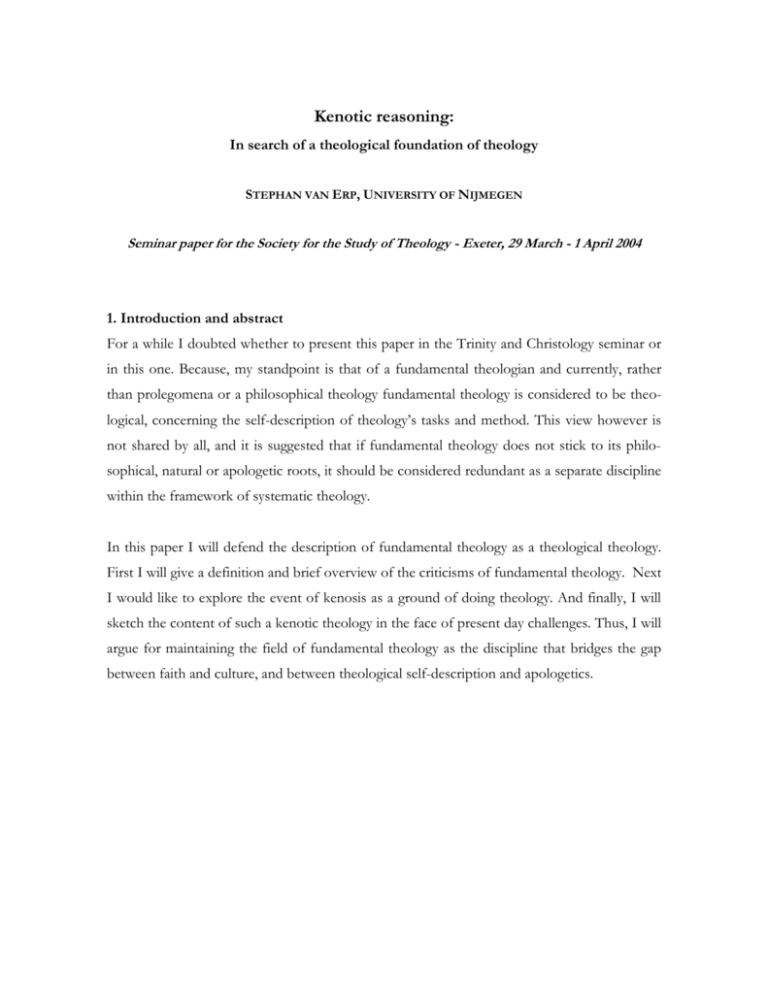
Kenotic reasoning: In search of a theological foundation of theology STEPHAN VAN ERP, UNIVERSITY OF NIJMEGEN Seminar paper for the Society for the Study of Theology - Exeter, 29 March - 1 April 2004 1. Introduction and abstract For a while I doubted whether to present this paper in the Trinity and Christology seminar or in this one. Because, my standpoint is that of a fundamental theologian and currently, rather than prolegomena or a philosophical theology fundamental theology is considered to be theological, concerning the self-description of theology’s tasks and method. This view however is not shared by all, and it is suggested that if fundamental theology does not stick to its philosophical, natural or apologetic roots, it should be considered redundant as a separate discipline within the framework of systematic theology. In this paper I will defend the description of fundamental theology as a theological theology. First I will give a definition and brief overview of the criticisms of fundamental theology. Next I would like to explore the event of kenosis as a ground of doing theology. And finally, I will sketch the content of such a kenotic theology in the face of present day challenges. Thus, I will argue for maintaining the field of fundamental theology as the discipline that bridges the gap between faith and culture, and between theological self-description and apologetics. 2 Kenotic reasoning 2. Fundamental theology, definition and criticisms Fundamental theology, usually an integral part of the Roman Catholic curriculum, finds its biblical justification in 1 Peter 3,15: “[S]anctify the Lord in your hearts, and always be ready to give a defence to everyone who asks you a reason for the hope that is in you.” The word ‘defence’ in this text befits the original apologetic nature of fundamental theology. Throughout the history of fundamental theology, its development was roughly conditioned by apologetics: First, by the polemic spirit of theology since the Reformation. Second, by the reflection on the academic status of theology, which resulted in the encyclopaedia or prolegomena of theology. And third, by the shift from a general dogmatics to a doctrine of principles and foundations of theology. Fundamental theology is a discipline that is in dialogue with the culture it participates in and with academics from other disciplines.1 Currently, the confrontation of theology with a variety of literal and historical methods of late- and postmodern thought has especially in continental theology caused an increase in the number of fundamental theologies, and until this day it seems that theologians have become obsessed with method.2 Suffering from the same obsession, I define fundamental theology as the methodological selfreflection of theology. It is the study of theological foundations of the validity and authority of sources and methods of the various subdisciplines, like historical, literal, dogmatic and practical theology. Its task is to critically judge the presuppositions and argumentations of theological standpoints.3 Hence, I would argue that fundamental theology is a theological discipline per se that might function as prolegomena, but theoretically comes after theology. 1 In catholic theology, the field of fundamental theology still has not recovered from its position in the neoscholastic manuals of the late nineteenth and early twentieth centuries, when it was either called praeambula fidei, seeking answers to the question as to how divine revelation and human reason are related, whereby faith was justified as a free human act in the presence of the demands of reason, or analysis fidei, focused on the search for infallible certainty of the subject of faith.1 2 Cf. K. Tanner, How I changed my mind, in: D.C. Marks [ed.], Shaping a theological mind. Theological context and methodology, Aldershot 2002, 115-122, 115. 3 Cf. 1 Peter 3,15: “But sanctify the Lord God in your hearts: and be ready always to give an answer to every man that asketh you a reason of the hope that is in you with meekness and fear.” Kenotic reasoning 3 Non-foundationalism Everyone who tries to find rational foundations for Christian faith or theology, will immediately meet opponents who suggest other, competing foundations or argue that in principle such an enterprise could never succeed. A first set of criticisms is directed against the foundational claim of fundamental theology. The argument of nonfoundationalist philosophers such as Quine, Rorty and Davidson against foundationalism in general exposes the objectivist expectations of modern knowledge. According to these philosophers foundational thought wrongly justifies claims to knowledge by an illegitimate appeal to the authority of universal principles of understanding, or arbitrarily drawing a limit where none could possibly exist and then designating that limit as the true foundation for all knowledge.4 Moreover, to claim that theological knowledge has such an ultimate foundation implies a privileged or basic class of beliefs that are intrinsically credible.5 Remarking the ever-receding horizon of an infinite regress of justification, the nonfoundationalist argument is especially valid for the very existence of a field like fundamental theology.6 In the light of the nonfoundationalist critique, establishing a rational foundation for divine revelation seems an impossible goal.7 One way to escape this dispute is to argue that the rationality of theology is constituted by coherence and consistency. Although this might save theological discourse the embarrassment of being irrational, it does not fully account for theology’s possibility to reason about God. If it were true that being rational means having and applying knowledge that is based upon firm and definitive foundations, neither external logical criteria for rationality, nor an internal set of credible beliefs would justify the project of fundamental theology. 4 J. Wentzel van Huyssteen, Book review of J. Thiel, Nonfoundationalism, in: Theology today 52 (1996) 4, 521-524, 522. 5 Id., Essays in postfoundationalist theology, Grand Rapids 1997, 226. 6 Thus, the nonfoundationalist critique applies particularly to the transcendental method that seeks fundamental philosophical principles that form the first and definitive principles for theological knowledge. 7 Cf. S.J. Grenz, J.R. Franke, Beyond foundationalism. Shaping theology in a postmodern context, Louisville 2001, 28-37. 4 Kenotic reasoning Natural theology A second set of criticisms is directed against the claim that it is possible to demonstrate the possibility of divine revelation by means of human reason. Karl Barth is without doubt the main advocate of this position, which is best described as a radical dichotomous dualism of revelation and reason. As you all know, the theological prolegomena to his Church Dogmatics do not form a philosophical introduction to theology, but a doctrine of the Trinity.8 This is a significant theological choice, and it reflects Barth’s opinion that the one and only true justification of faith is the sovereignty of God and not the intellectual categories of Enlightenment philosophy. For Barth, the problem of theology is that humanity is separated from God. Therefore, he argues that theology is only possible beyond scientific boundaries, and highly limited since it can only be a witness to something, which it cannot justify. On the assumption that fundamental theology and natural theology are identical, Barth’s criticism of natural theology became a criticism of fundamental theology. This identification is understandable, because the objects of natural theology were the praeambula fidei, the religious truths that can be known by human reason, contrary to the truth that can be known through revelation alone. The only escape from this criticism would be to declare that faith and reason are identical and that it is impossible to justify faith by something other than by the sheer fact of faith itself, which then would be adequately reasonable. But that would turn fundamental theology into a meaningless tautological act, which would make it completely redundant. Yet, it is important to justify the tasks and methods of theology in a changing cultural and academic context. In Christian theology this attempt to correlate faith and culture is grounded in the belief in God and His revelation in the world through Christ. As such, the ground of Christian theology, which argues for the legitimacy of one’s theological method in the face of society’s needs and contemporary notions of rationality established by non-theological academic disciplines, is itself grounded in Christian faith. 8 K. Barth, Kirchliche Dogmatik, I,1. Prolegomena, München 1932. Kenotic reasoning 5 This double focus of theology, on Christ and culture, is the problem of fundamental theology. Contemporary theological self-understanding must always also be an expression of the awareness that theological doctrines sub ratione Dei are confronted with dissimilar notions of rationality. The current tasks of fundamental theology should originate in this dissimilarity, and every answer as to what theology is, should articulate it, rather than seek possible correlations between different views on the world and humanity. Merely proclaiming the particularity of Christian faith however will not suffice. If Christian doctrines are grounded in conversions and convictions alone, an idiosyncratic and non-communicable method will be the result. Therefore, balancing between faith and reason, theologians express their conviction that divine revelation is not merely a matter of faith or metaphysical opinion, but that it is also possible to communicate it to others, believers and non-believers alike. 3. Kenosis, definition and background Confronted by this problem of fundamental theology and in an attempt to understand theology’s double focus on Christ and culture, I would like to propose reading Philippians 2,5-11 as a biblical source to define the nature of fundamental theology: “(5) Let this mind be in you which was also in Christ Jesus, (6) who, being in the form of God, did not consider it robbery to be equal with God, (7) but emptied Himself (made Himself of no reputation), taking the form of a bondservant, and coming in the likeness of men.” Throughout the history of theology, kenosis, or self-emptying, has been at the heart of Christian understandings of incarnation and redemption that take place through a divine self-emptying in and through and as Jesus. But only recently philosophers and theologians have begun to acknowledge the dialogical insights and demands of kenosis, and regard it as a key concept in understanding the life of faith. The Italian philosopher Gianni Vattimo for example rereads the incarnation as an act of kenosis, as an act in which God turned everything over to human beings. This enables Vattimo to make his perhaps most startling and important claim that secularisation is the constitutive trait of an authentic religious experience. Vattimos interpretation mirrors the claim in twentieth century Roman Catholic theology that the church should incarnate in the world, as Jesus has 6 Kenotic reasoning incarnated in a sinful world. A theology of incarnation was not at stake then, but rather the place of the church in the world. Vattimo however reduces kenosis to self-relating to others in a secularised, church-less and even God-less context. Against Vattimo, Graham Ward has suggested that kenosis, instead of the absence of God, is the strongest possible, redeeming presence of God in the world. Similarly, John Milbank has defined kenosis as the incarnation of God in human language. Milbank suggests that human language thus participates in the life of the Kingdom to come, precisely because it is disrupted by Christ’s kenosis. But one might wonder whether Ward’s and Milbank’s interpretations of kenosis as presence and participation do justice to the humiliation that characterises the event of Christ’s kenosis. Hans Urs von Balthasar I turn to Hans Urs von Balthasar’s kenotic theology, which according to me does justice to the ambivalence of the idea of God’s humiliation. By distinguishing three forms of kenosis Balthasar avoids a reductive interpretation of the idea of kenosis as either absence or redeeming presence. The first and primary kenosis is the intratrinitarian.9 If the incarnation is the foundation of all analogies in the world, there already has to be freedom in God and therefore a difference and a separation within the Trinity. This difference within God however is at the same time absolute unity. The cohesion between unity and difference in the world is an analogical representation of that which is in God, a precondition of all ‘becoming’ in the world.10 The second kenosis is creation. The idea that God lives in three hypostases has nothing to do with contingency, but is rather the expression of the fullness of divine being, while worldly being is limited by its essence. On the one hand, this means that God is absolute and sovereign and that the world is not necessary for His Being. This seems to make the chasm between God and man even more unbridgeable. On the other hand, the revelation of the Trinity does bridge 9 Cf. G. De Schrijver, Hans Urs von Balthasars Christologie in der Theodramatik. Trinitarische Engführung als Methode, in: Bijdragen. Tijdschrift voor filosofie en theologie 59 (1998), 141-153, 142-143; G. Ward, Kenosis: Death, discourse and resurrection, in: L. Gardner, et al., Balthasar at the end of modernity, Edinburgh 1999, 15-68. Balthasar is not consistent in his treatment of the topic of ‘kenosis’. In Theodramatik, Balthasar distinguishes between the intratrinitary kenoses, and three ‘economic’ kenoses: creation, incarnation and atonement. In Theologik, the latter is part of the second one. In Theologie der drei Tage and the final essay of Herrlichkeit III,1, he also distinguishes a kenosis of the human subject. See also chapter eight of this book. 10 Cf. G. O’Hanlon, The immutability of God in the theology of Hans Urs von Balthasar, Cambridge 1990. Kenotic reasoning 7 this chasm in a certain manner. If there is such a thing as difference and separation in the divine identity, which is both image of the Father and primal image of all things created, if furthermore it encompasses the Spirit that is the love between the divine persons, then the fact that the creation differs from God is defined in a positive relation to God. However, according to Balthasar, this relation will become a negative one if human freedom appeals to an abstract idea of autonomy instead of owing itself to God’s primal kenosis within the creational one. The third kenosis Balthasar distinguishes is the incarnation. The culminating event of this last kenosis is the death of Christ on the Cross. The final confrontation between God and man takes place when the incarnate Son gives himself away on the Cross, which is the decisive moment between God’s love and human sin and suffering. For Balthasar, it is the incarnated Son who is determined by the Spirit, and who serves as the mediator of the Father’s will. Christ placed himself under the will of the Father in the primal intratrinitarian kenosis and allows the Spirit, made available by the Father in the second kenosis, to have power over him as a “rule” of the Father’s will. He does this in order to permit the Spirit resting upon him in all fullness to stream out from himself at the end of his mission in death and resurrection, which forms the third kenosis.11 It is only in this way, through Christ, that the Spirit can do its inspirational work in the world, enabling the human mind to receive the truth of God.12 11 Cf. E. Oakes, Pattern of redemption, 290. 12 These kenotic processions determine the historical events between God and man, and must not be interpreted, as Hegel did, as a necessity to go outside the inner dialectic of the absolute Spirit to find the dynamism revealed in scripture. Nor should it be equated with the event of the destiny of Being, as Heidegger did. Instead, the limitation of Being opened the possibility of conceiving the Absolute and sovereign freedom of God in a kenotic moment which is founded on a prior movement of the divine kenosis. 8 Kenotic reasoning 4. Kenosis as theological foundation: the double surrender to Christ and Culture Balthasar’s triple kenosis - immanent Trinity, creation and incarnation - offers a solution to the problem of fundamental theology: the double focus on Christ and culture. Understanding the event of kenosis as a theological foundation presents us with trinitarian, christological and pneumatological grounds of fundamental theology in two movements: First, theology communicates faith with others. Reflecting the divine Spirit that empties itself in the world by becoming something other and yet remaining the same, theology performs its task by surrendering to a broad cultural audience of others, believers and non-believers alike, without ceasing to be self-descriptive. It reads scripture and interprets tradition in and for the culture to which it belongs. However, a straightforward continuity between scripture and tradition cannot be assumed. If theology mirrors the kenotic Spirit, then it must to all intents and purposes be anti-apologetic. It ought not to point exclusively to one’s own standpoint but should instead be willing to ‘empty itself’ to address the questions and concerns of contemporary culture. The kenotic motivation for this subordination to culture constitutes theology’s self-descriptive task as being constructive, rather than merely responsive or explanatory.13 The constructive study of tradition is constituted by the academic freedom to explore new perspectives or even possibilities of decentring dominant streams within tradition, which in itself is and always has been a matter of diversity. Moreover, although theologians should positively acknowledge that they are the pupils of that tradition of diversity, they should also allow themselves to make room for new perceptions of givenness and hope, and thus for the possibility of ongoing revelation. Tradition therefore is not the authority but the inviting availability of the history of ideas and beliefs, because it has generated a language and content in which all may partake freely and responsibly. 13 Constituted by the analogy of divine kenosis, theology will not fall into the danger of ‘false humility’ that John Milbank has warned against: “The pathos of modern theology is false humility. For theology, this must be a fatal disease, for once theology surrenders its claim to be a metadiscourse, it cannot any longer articulate the word of the creator God, but is bound to turn into the oracular voice of some finite idol, such as historical scholarship, humanist psychology, or transcendental philosophy. If theology no longer seeks to position, qualify or criticize other discourses, then it is inevitable that these discourses will position theology: for the necessity of an ultimate organizing logic cannot be wished away. A theology ‘positioned’ by secular reason suffers two characteristic forms of confinement. Either it idolatrously connects knowledge of God with some particular immanent field of knowledge — ‘ultimate cosmological causes, or ‘ultimate’ psychological and subjective needs. Or else it is confined to intimations of a sublimity beyond representation, so functioning to confirm negatively the questionable idea of an autonomous secular realm, completely transparent to rational understanding.” J. Milbank, Theology and social theory. Beyond secular reason, Oxford 1990, 1. Kenotic reasoning 9 Theology therefore, must mediate and inspire an open communication, with room for new articulations of religious experiences and yet unexplored images of faith. Thus, theology performs the communication of faith with others in a kenotic fashion, analogical to the divine kenosis: away from itself and inviting a variety of possible responses and conversations. Second, theology constructively anticipates the life in the Kingdom to come, through the redemptive ascension in Christ. This anticipation entails that every proposed construction of faith should express the awareness of the fallibility and indefiniteness of all theological statements, thereby safeguarding the dynamics of a living tradition of free and equal human beings. In fact, it also shows that the communication with others in the first kenotic movement of theology, anticipates the mediation of God’s gift of freedom and thus in a sense of becoming “Christ to others”.14 The indefiniteness of theological construction constitutes the human longing for God. That longing is expressed in other words than the Word it is assumed to proceed from. More often than not, these words do not find their way back to their origin. This is why longing for the divine is envisioned in terms of human impossibilities, in feelings of guilt and the experiences of human sin and suffering. Theological reasoning therefore must take up the responsibility to present the Christian narrative as the affirmation of human life in its furthest consequences, without ignoring its impossibilities. Christ is the event in which these consequences are conceived to the full and Christian theological reason is ultimately subordinate to that event, which has given human beings the freedom to long for the life in a world that is wholly other. Because of this double ‘surrender’, to culture and Christ, I suggest defining theology as ‘kenotic reasoning’.15 The art of theology is to reason kenotically. It finds its foundation in the divine Logos that progressively appears in the givenness of being. Consequently, it is constructively an14 This is a quotation of Luther by Richard Bauckham from his God and the crisis of freedom. Biblical and contemporary perspectives, Louisville 2002, 209. 15 Cf. R.H. Niebuhr, Christ and culture, New York 1951. In this book, Niebuhr distinguishes five basic ways that Christians deal with culture: Christ against culture, Christ above culture, Christ and culture, Christ transforming culture, and Christ as culture. To define theology as ‘kenotic reasoning’ means that I, like Niebuhr, choose the fourth option, that interprets culture as something that will be the restoration of creation to its original, God-given purpose. See also: R.W. Jenson, Christ as culture. Christ as polity, in: International journal for systematic theology 5 (2003), 323-329. 10 Kenotic reasoning ticipated in the hope for redemption. Both givenness and hope thus constitute theological reason and provide the tools to read scripture and interpret tradition for a variety of audiences and a diversity of beliefs. Only within this spirit of givenness and hope can theology engage in the logos of either modernity or postmodernity and share in the discourse of other disciplines and the particular articulations of meaning in the life of others. At the same time, theology can only address its tasks kenotically by engaging in the communication with others. This engagement constitutes the life of faith and does not merely lead to a theological self-description of the content of faith but also encourages possible ways of transforming both culture and tradition to share in the spirit of givenness and hope. And yet, it paradoxically envisions the desire that its hope is met with something utterly inexpressible and unhoped for. In other words, that its constructions have been and will be embraced by the kenotic event of life in the Word of God.

